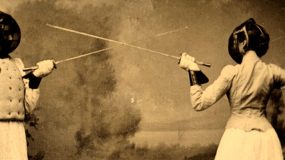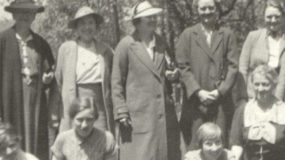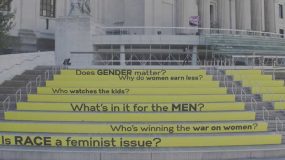2023 Berkshire Conference on the History of Women, Genders and Sexualities

Home | Welcome | About | Program | Book Videos | Sponsors | Exhibitor Ads | Registration | FAQ
A Brief History of the Berkshire Conference of Women Historians
The Berkshire Conference of Women Historians, which sponsors the Berkshire Conference on the History of Women, Genders, and Sexualities, was founded in 1930 in response to the marginalization faced by women historians in a male-dominated profession. The small number of women with Ph.D. degrees tended to work in women’s colleges, where they were also outnumbered by men. Although they were members of the American Historical Association, women were barred from the “smokers” at the AHA, private men’s clubs, an annual retreat held by J. Franklin Jameson (one of the founders of the AHA) in New London, CT, and other social occasions when graduate students and early-career scholars were introduced to prominent colleagues by their mentors. Other forms of exclusion — specifically affecting women of color who were active in teaching, preservation, and other forms of what we would now call public history — were, unfortunately, not addressed by the founders as they worked to create a place for themselves in the profession.
In 1929, a number of women returning from the annual AHA meeting decided that women historians needed their own organization. And by 1936, their spring weekend retreats in the Berkshire Mountains of Massachusetts had become integral to the Berkshire Conference of Women Historians, evolving into what we now call the Little Berks. The Little Berks continues to meet annually, combining a small number of panels and papers, discussions, business meetings, and socializing with colleagues.
The Berkshire Conference began to see a larger role for itself after World War II, as women earned the Ph.D. in greater numbers, and renewed their fight to be recognized in the historical profession. Enthusiasm for women’s history among second wave feminists in the 1960s and 1970s made the Berkshire Conference a magnet for a new generation of ambitious scholars. Although women are now accustomed to being honored by all historical societies, that was not the case when the organization established a book prize in 1968 and an article prize in 1971. The list of winners in these early years not only shows the emergence of women’s history as a field, with its own themes and methodologies, but the ways in which women and feminism transformed historical scholarship—a main theme of our plenary on Friday evening celebrating the 50th anniversary of the Big Berks.
The inaugural Big Berks was held in 1973 at Douglass College, Rutgers University, resulting in the first edited collection in the field of women’s history, Clio’s Consciousness Raised: New Perspectives on the History of Women (Harper & Row, 1974), edited by Lois Banner and Mary S. Hartman. Perhaps the excitement of that volume propelled the Berkshire Conference into a second scholarly meeting the following year at Radcliffe College, Harvard University. The fast-growing organization soon switched to a biennial model, and then to triennial meetings after 1978. Like many second wave feminist organizations, these conferences also featured a dance on the final evening of the conference, which continues to this day.
Between 1974 and 1993, the Big Berks meetings were held at one of the original women’s colleges in the northeastern United States. In 1996, recognizing its growing national and international constituency, the conference began to move to the south (University of North Carolina), the west (Scripps College), and the Midwest (University of Minnesota). The 2014 conference at the University of Toronto was the first conference convened outside the United States. This summer, we are back on the West Coast for only the second time.
The Big Berks is now the largest conference on historical scholarship on women, genders, and sexualities, and is attended by scholars from diverse fields, disciplines, and countries. Some of the past leaders of the Berkshire Conference, which arose from a climate of exclusion almost a century ago, have gone on to lead other historical organizations, notably the AHA. Thanks to organizations like the Berkshire Conference and sister organizations in women’s gender and sexuality history—several of which are co-sponsoring panels or holding meetings in conjunction with the Berks, as you will see in this program—we are no longer excluded.
The Berkshire Conference also has a long history of creating cooperative relationships with other organizations that advance the cause of women in the historical profession. For example, between 1982 and 2001, the Berkshire Conference awarded one of the prestigious Bunting Fellowships at the Radcliffe Institute, Harvard University. In 1982, the Berkshire Conference, in cooperation with the Coordinating Council of Women in the Historical Profession (now the Coordinating Council for Women in History), created the CCWH/Berks Graduate Student Fellowship.
In 1981, The Berkshire Conference was incorporated in the State of Maryland as a 501(3) c, allowing the organization to create an endowment to support our activities and prizes from membership fees, any profits from the triennial conference, and tax-deductible donations.
Santa Clara University, A Brief Overview
Santa Clara University is a private (Jesuit) university with approximately 6,000 undergraduate and 3,000 graduate students. Located in the City of Santa Clara in the heart of Silicon Valley, it is about five miles from downtown San Jose (pop.1 million) and 50 miles from San Francisco (pop. 800,000). SCU’s diverse student body can select from about 40 undergraduate majors in the College of Arts and Sciences and about 10 undergraduate majors each in the Schools of Business and Engineering. SCU has graduate programs in Engineering, Law, Business, Education, Counseling Psychology, Pastoral Ministries, and Theology. SCU graduates include Silicon Valley innovators, prominent artists in the film and television industries, numerous elected and appointed officials in Washington and Sacramento (including the two most recent governors of California), and, of course, educators at all levels.
Established in 1851, Santa Clara University is the oldest operating institution of higher learning in California. Almost 75 years earlier, in 1777, Franciscan missionaries established a mission church they named for St. Clare of Assisi on the unceded land of the Ohlone people—hence the name of the university, the city, and the county. Floods and earthquakes destroyed the church buildings on several occasions, and the last church to be rebuilt, in 1929, is directly next to an old Native burial ground. An expansionist United States seized vast territories following victory in the Mexican-American War (1846-48), which became the states of California, Utah, Nevada, Arizona, and New Mexico. California became a state in 1850, and with a growing population, there was a growing demand for education—for men and boys, that is. Santa Clara College offered its first preparatory classes in 1851, its first college-level classes in 1853, and the first BA degree in California in 1857. The addition of the schools of law and engineering led Santa Clara College to be renamed the University of Santa Clara in 1912. The university assumed its current name, Santa Clara University, in 1985.
The most path-breaking development, one that allows us to be here today, was the admission of 75 women students in 1961. Women now make up about half the student body. When I arrived at SCU in 1981, there was just a single woman faculty member in the History Department. She was tasked by the university president to sit in on various departments’ searches to help identify candidates who could also offer courses in women’s and gender studies to allow her to begin offering a certificate in Women’s Studies (we now have a full degree-offering department in Women’s and Gender Studies). I was one of those hires.
Barbara Molony, SCU History Department
About our 2023 Conference Image

“We Are Muwekma Ohlone”
Artist: Alfonso E. Salazar
Photographer: Ian Lundie
The central image is of Charlene Nijmeh, Chairwoman of the Muwekma Ohlone. She will participate in the 2023 Presidential Opening Plenary.
Learn more about “We Are Muwekma Ohlone”: “The Muwekma Ohlone Are Still Here” by Julia Halperin Jackson, SJSU Spartan Spotlight
Conference FAQ
Need info on how to get from the airport to the university? Where and how to check in if you’re staying in a dorm? How to register? How to get around campus? Please visit FAQ > for this info and more!



